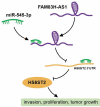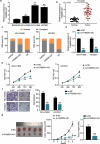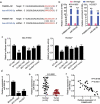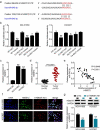Role of lncRNA FAM83H antisense RNA1 (FAM83H-AS1) in the progression of non-small cell lung cancer by regulating the miR-545-3p/heparan sulfate 6-O-sulfotransferase (HS6ST2) axis
- PMID: 35260044
- PMCID: PMC8973780
- DOI: 10.1080/21655979.2022.2031668
Role of lncRNA FAM83H antisense RNA1 (FAM83H-AS1) in the progression of non-small cell lung cancer by regulating the miR-545-3p/heparan sulfate 6-O-sulfotransferase (HS6ST2) axis
Abstract
Long non-coding RNAs (lncRNAs) are crucial regulators of cancer pathogenesis and are potentially useful diagnostic and prognostic biomarker tools. FAM83H antisense RNA1 (FAM83H-AS1) has been reported to be a vital regulator of different cancers; however, little attention has been paid to its significance in lung cancer. Non-tumorigenic lung cell line BEAS-2B and adenocarcinoma lung cancer cell lines NCI-H1299 and HCC827 were used in the present study. In addition, RNA immunoprecipitation, Western blotting, quantitative reverse transcription-PCR (qRT-PCR), and luciferase reporter assays were used to dissect the role of FAM83H-AS1 in lung cancer progression. The results revealed that FAM83H-AS1 is highly expressed in lung cancer tissues, and its knockdown inhibits lung cancer cell invasion and proliferation reducing tumor growth in vivo. Besides, we found that FAM83H-AS1 targets miR-545-3p, and a negative correlation exists between their expression in lung cancer tissues. Simultaneously, miR-545-3p negatively regulates heparan sulfate 6-O-sulfotransferase (HS6ST2). Moreover, inhibition of miR-545-3p promoted HS6ST2 protein expression and lung cancer cell invasion. FAM83H-AS1 favors non-small cell lung cancer by targeting the miR-545-3p/HS6ST2 axis, supporting the possibility of developing FAM83H-AS1 as a target for NSCLC intervention.
Keywords: FAM83H-AS1; HS6ST2; Lung cancer; NSCLC; miR-545-3p.
Conflict of interest statement
No potential conflict of interest was reported by the author(s).
Figures







Similar articles
-
The emerging roles and mechanisms of FAM83H‑AS1 in cancer: Pathophysiology and therapeutic implications (Review).Oncol Lett. 2025 Apr 7;29(6):270. doi: 10.3892/ol.2025.15016. eCollection 2025 Jun. Oncol Lett. 2025. PMID: 40235683 Free PMC article. Review.
-
LncRNA NNT-AS1 promotes non-small cell lung cancer progression through regulating miR-22-3p/YAP1 axis.Thorac Cancer. 2020 Mar;11(3):549-560. doi: 10.1111/1759-7714.13280. Epub 2020 Jan 10. Thorac Cancer. 2020. PMID: 31923353 Free PMC article.
-
Long non-coding RNA FAM83A antisense RNA 1 (lncRNA FAM83A-AS1) targets microRNA-141-3p to regulate lung adenocarcinoma cell proliferation, migration, invasion, and epithelial-mesenchymal transition progression.Bioengineered. 2022 Mar;13(3):4964-4977. doi: 10.1080/21655979.2022.2037871. Bioengineered. 2022. PMID: 35164653 Free PMC article.
-
E2F1-Induced Overexpression of Long Noncoding RNA SBF2-AS1 Promotes Non-Small-Cell Lung Cancer Metastasis Through Regulating miR-362-3p/GRB2 Axis.DNA Cell Biol. 2020 Jul;39(7):1290-1298. doi: 10.1089/dna.2020.5426. Epub 2020 May 4. DNA Cell Biol. 2020. PMID: 32364763
-
A review on the role of NCK1 Antisense RNA 1 (NCK1-AS1) in diverse disorders.Pathol Res Pract. 2023 May;245:154451. doi: 10.1016/j.prp.2023.154451. Epub 2023 Apr 5. Pathol Res Pract. 2023. PMID: 37028107 Review.
Cited by
-
LncRNA PCAT6 promotes proliferation, migration, invasion, and epithelial-mesenchymal transition of lung adenocarcinoma cell by targeting miR-545-3p.Mol Biol Rep. 2023 Apr;50(4):3557-3568. doi: 10.1007/s11033-023-08259-x. Epub 2023 Feb 14. Mol Biol Rep. 2023. PMID: 36787056 Free PMC article.
-
Heparan sulfate 6-O-sulfotransferase 2 promotes gastric cancer progression by modulating the TGF-β/smad2/3 pathway.Am J Transl Res. 2024 Dec 15;16(12):7924-7936. doi: 10.62347/LWZR1836. eCollection 2024. Am J Transl Res. 2024. PMID: 39822499 Free PMC article.
-
Pancancer analysis of the correlations of HS6ST2 with prognosis, tumor immunity, and drug resistance.Sci Rep. 2023 Nov 6;13(1):19209. doi: 10.1038/s41598-023-46525-x. Sci Rep. 2023. PMID: 37932473 Free PMC article.
-
The emerging roles and mechanisms of FAM83H‑AS1 in cancer: Pathophysiology and therapeutic implications (Review).Oncol Lett. 2025 Apr 7;29(6):270. doi: 10.3892/ol.2025.15016. eCollection 2025 Jun. Oncol Lett. 2025. PMID: 40235683 Free PMC article. Review.
-
Current and future perspectives on the regulation and functions of miR-545 in cancer development.Cancer Pathog Ther. 2023 Sep 5;2(3):142-154. doi: 10.1016/j.cpt.2023.09.001. eCollection 2024 Jul. Cancer Pathog Ther. 2023. PMID: 39027151 Free PMC article. Review.
References
-
- Siegel RL, Miller KD, Jemal A. Cancer statistics, 2015. CA Cancer J Clin. 2015;65(1):5–29. - PubMed
-
- Motoi N, Szoke J, Riely GJ, et al. Lung adenocarcinoma: modification of the 2004 WHO mixed subtype to include the major histologic subtype suggests correlations between papillary and micropapillary adenocarcinoma subtypes, EGFR mutations and gene expression analysis. Am J Surg Pathol. 2008;32(6):810–827. - PubMed
MeSH terms
Substances
LinkOut - more resources
Full Text Sources
Other Literature Sources
Medical
Molecular Biology Databases
Miscellaneous
